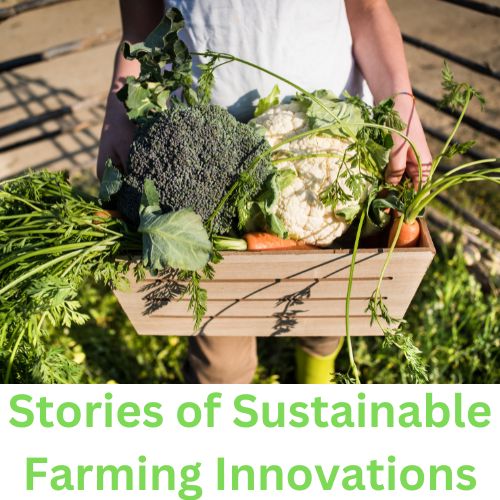Agroforestry, the practice of integrating trees with crops and/or livestock, is gaining momentum as a sustainable and innovative approach to farming. This holistic system not only boosts agricultural productivity but also promotes environmental sustainability. In this essay, we embark on a journey through the “Agroforestry Chronicles,” exploring inspiring stories of sustainable farming innovations that are transforming landscapes, improving livelihoods, and nurturing the planet.
Chapter 1: The Tale of Intercropping Harmony
One of the captivating stories within the Agroforestry Chronicles is that of intercropping harmony. In this practice, farmers strategically plant different crops together to maximize land use, improve soil health, and enhance overall productivity.
Innovative Story 1: The Milpa System in Mexico
In Mexico, indigenous communities have cultivated maize, beans, and squash together in a system known as “milpa” for centuries. This harmonious trio not only complements each other in terms of growth requirements but also benefits the soil. Maize provides support for climbing beans, while squash acts as a natural mulch, preventing weed growth and retaining soil moisture. This ancient practice showcases the wisdom of traditional knowledge in sustainable agriculture.
Chapter 2: The Agroforestry Orchards of Hope
Agroforestry orchards represent a beacon of hope for farmers looking to harness the benefits of both trees and fruit-bearing crops.
Innovative Story 2: The Breadfruit Forests in the Caribbean
In the Caribbean, farmers have embraced the cultivation of breadfruit trees alongside other fruit trees like mangoes and avocados. Breadfruit, a highly nutritious and versatile crop, not only provides food security but also contributes to income generation. The trees provide shade to other fruit trees, reduce soil erosion, and sequester carbon. These agroforestry orchards exemplify a sustainable and resilient approach to food production in the face of climate change.
Chapter 3: The Livestock and Silvopasture Revolution
Silvopasture, the integration of trees and pasture for livestock, is a remarkable chapter in the Agroforestry Chronicles.
Innovative Story 3: The Alpaca Silvopasture in Peru
In the highlands of Peru, alpaca farmers have embraced silvopasture as a means to improve the well-being of their herds and the environment. They plant native trees like quinual and alder alongside pastures, providing shade and shelter for alpacas. This practice not only enhances the animals’ health but also increases the productivity of pastures by improving soil fertility and moisture retention. The alpaca silvopasture model demonstrates how agroforestry can empower livestock farmers to adapt to changing climates while preserving their ecosystems.
Chapter 4: The Forest Gardens of Abundance
Forest gardens, designed to mimic natural ecosystems, are a testament to the diversity and resilience that agroforestry can offer.
Innovative Story 4: The Permaculture Forest Garden in England
In England, permaculture enthusiasts have created thriving forest gardens that resemble self-sustaining ecosystems. These gardens feature a diverse mix of fruit trees, bushes, herbs, and wildlife-friendly plants. They require less maintenance than conventional gardens and yield a rich variety of produce throughout the year. The permaculture forest garden is an inspiring example of how agroforestry principles can be applied in diverse geographical settings to promote sustainability and abundance.
Chapter 5: The Agroforestry Cooperatives of Unity
Cooperative farming models that embrace agroforestry practices are transforming communities and fostering a sense of unity among farmers.
Innovative Story 5: The Coffee Cooperatives in Central America
In Central America, coffee cooperatives have adopted agroforestry techniques to grow coffee in the shade of native trees. This approach not only improves coffee quality but also supports wildlife conservation and enhances soil health. These cooperatives empower small-scale coffee farmers, strengthen their collective bargaining power, and promote sustainable farming practices in the coffee industry.
Chapter 6: The Path Forward
The Agroforestry Chronicles are filled with inspiring tales of innovation, resilience, and sustainability. As we look to the future, there are essential lessons to be learned from these stories.
Agroforestry offers a path forward towards a more sustainable and regenerative agriculture. Its principles can be adapted to various contexts, from small-scale family farms to large commercial operations. Governments, NGOs, and agricultural organizations can play a pivotal role in providing support, training, and resources to farmers interested in adopting agroforestry practices.
Moreover, consumer awareness and demand for sustainably grown products can drive the adoption of agroforestry on a broader scale. When consumers prioritize products that come from agroforestry systems, it creates incentives for farmers and businesses to embrace these practices.
Conclusion
In conclusion, the Agroforestry Chronicles are a testament to the transformative power of sustainable farming innovations. These stories remind us that agriculture can be a force for good, nurturing both the planet and the livelihoods of those who tend to it. By drawing inspiration from the diverse experiences of farmers around the world, we can pave the way for a more sustainable, resilient, and prosperous future for agriculture and our planet. Agroforestry is not just a farming practice; it’s a powerful narrative of hope and possibility in our journey towards a sustainable future.
